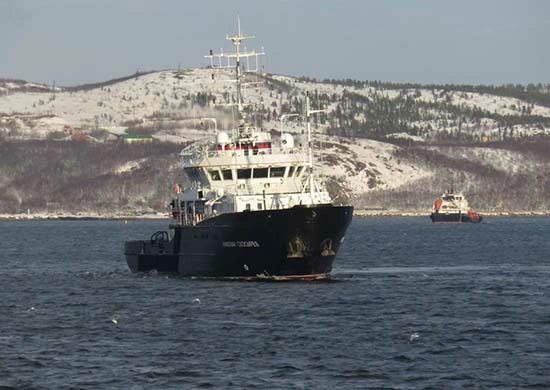

In the course of expedition, the hydrographers discovered several ships that sank during the Great Patriotic War (Image courtesy: Ministry of Defence, Russia)
<p>
<strong>In a complex joint expedition with the Russian Geographical Society, the hydrographers of the Russian Navy&#39;s Northern Fleet have confirmed the coordinates of a Soviet patrol vessel lying at the bottom of the Barents Sea since the Second World War.<br />
</strong><br />
The location of patrol ship &#39;Tuman&#39;, which sank in the Arctic waters after a battle with three German destroyers 80 years ago, was confirmed by the crew of the hydrographic vessel &#39;Romuald Muklevich&#39; during &#39;Remember the War&#39; expedition.<br />
<br />
As Romuald Muklevich with an oceanographic group on board completed research tasks in the Barents Sea and arrived at the permanent base – the village of Mishukovo near Murmansk in the extreme northwest of Russia – the Northern Fleet announced Thursday evening that the objectives of the expedition, planned for 2021, have been completed.<br />
<br />
In the course of expedition, the hydrographers also discovered several ships that sank during the Great Patriotic War, including Royal Navy&#39;s Bluebell corvette, the Matabele destroyer, the Passat patrol ship and an unknown ship – presumably the RT-67, which perished along with the Passat.<br />
<br />
Earlier, in August and September, several underwater objects were <a href="https://sc.mil.ru/social/health/news/more.htm?id=12371547@egNews">discovered</a> in the waters of the Barents and Kara Seas, off the coast of Severny Novaya Zemlya Island and the continental coast, where the routes of northern convoys passed during the war. Most of them are ships and vessels that had sunk in the early and middle of the 20th century.<br />
<br />
As the &#39;practical stage&#39; of the expedition ended, the research group also confirmed the coordinates of the previously discovered large hunter BO-224, submarine D-3 Krasnogravdeets, German submarines U-307 and U-387 and vessel convoy BD-5 which sank in 1944.<br />
<br />
The group had in August discovered a German bottom mine TMS in the Belushya Bay, supposedly delivered on September 3, 1944 by the German submarine U-956.<br />
<br />
The explosive item is within the previously established exclusion area and currently does not pose a threat to shipping.<br />
<br />
The research has been accompanied with the planned work of the Hydrographic Service of the Northern Fleet to collect information for updating maps, guides and aids for navigation, to study the bottom topography in the near sea zone, according to the results of which the information will be sent to replenish the oceanographic data banks of the Central Cartographic Production of the Navy.</p>
<p>
<strong>Also Read: <a href="https://www.indianarrative.com/world-news/four-decades-later-a-sunken-cambodian-warship-returns-to-land-with-tonnes-of-unexploded-ammunition-79574.html">Four decades later, a sunken Cambodian warship returns to land with tonnes of unexploded ammunition</a></strong></p>
<p>
<strong><br />
</strong></p>
Volker Turk, the UN High Commissioner for Human Rights, on June 17 expressed concern over…
Prime Minister Narendra Modi addressed the G7 Outreach Session on the theme 'Energy Security: diversification,…
Prime Minister Narendra Modi held a telephonic conversation with US President Donald Trump on the…
The launch of Axiom Mission 4, the fourth private astronaut mission to the International Space…
The Embassy of Iran in India on Wednesday shared a statement made by the Director-General…
India and Canada agreed to resume full diplomatic services, ending the thaw between the two…